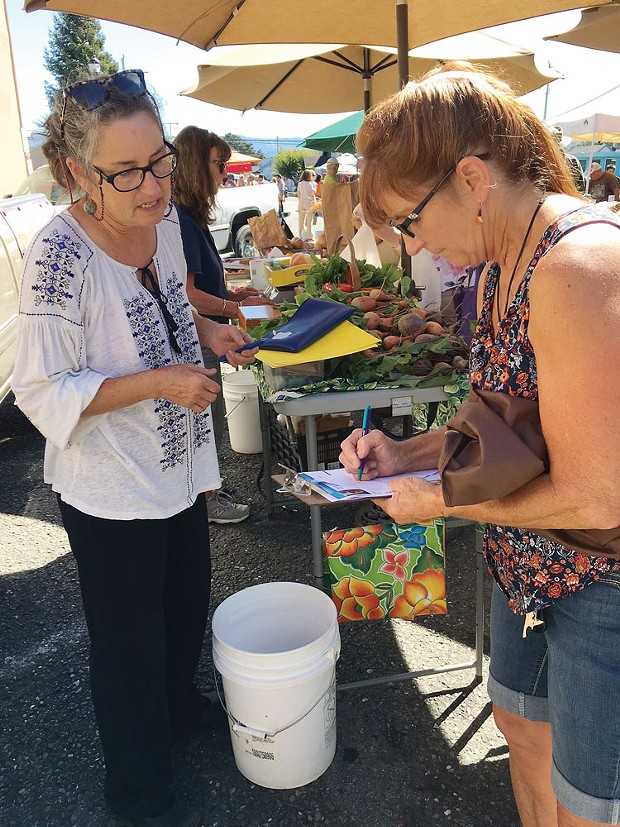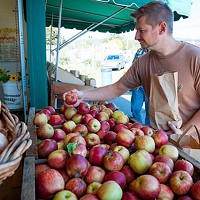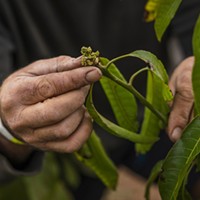
Courtesy of Humboldt County Office of Education
Donna Roudebush of Fortuna Union Elementary School District with Holly Kreb of Flood Plain Produce at the Fortuna Farmers Market.
[
{
"name": "Top Stories Video Pair",
"insertPoint": "7",
"component": "17087298",
"parentWrapperClass": "fdn-ads-inline-content-block",
"requiredCountToDisplay": "1"
}
]
The iconic image of a shiny, red apple is symbolic of "school" but getting an apple, or any other food, into the hands of a student is a complicated process involving rule compliance and paperwork. It's even more of an ask that the food be local. But Humboldt is making inroads in bringing local food to schools mostly due to its size and its diligent school food workers and coordinators.
Humboldt County has more than 30 independent school districts operating their own school meal programs. More than half of those districts are a single school, most of the time out in the cuts, trying to feed 100 or so students. It seems simple to feed them from our cornucopia of farmland, but feeding students is heavily regulated — if kids could eat red tape, everyone would be well fed.
"People become head cooks because they want to cook for kids, but they barely have time to do the cooking because they have to stay on top of the regulations and paperwork," says Erin Derden-Little, the Farm to School Coordinator for the Humboldt County Office of Education. "So HCOE brings them together for workshops, training and other things to help them through it."
Understanding and staying on top of the Escher drawing of changing COVID-era regulations has been a monstrous task for everyone involved. Timeframes shifting, summer feeding program extensions parceled out bit by bit, adjusting to the new school year — so much change has left the people feeding Humboldt's school children frazzled.
One major change was the extension of the Seamless Summer Food Program, where anyone under 18 can pick up a sack lunch, and even breakfast and supper in some districts, at a drop location. The program was discontinued in March before the U.S. Department of Agriculture stepped in to start it up again.
"People are trying to make plans to feed students," says Derden-Little. "In a normal year it's challenging; this year it's head spinning. Add supply chain interruption, etc., and it's been a year. But the school food people have been exceptional."
Seamless Summer was extended with a deadline more than a few times before the recent decision that it will extend through the entire 2020-2021 school year.
The order of operations for school food programs goes something like this: The USDA sets school meal regulations. The California Department of Education then administers the school lunch programs. Down the line, HCOE, which indeed uses an apple as its logo, provides educators, food service staff, students and families with tools and resources to support their nutrition programs in their districts. And HCOE is managing something that wouldn't be possible in counties with larger districts: the actual food that goes into the meals.
Procurement policies for school food have always been in place but in the last 10 years restrictions tightened around local purchasing. "When procurement guidelines came online, it was heart wrenching because we thought it was going to steal momentum for farm-to-school produce, but it turns out we are in a sweet spot in Humboldt county," says Derden-Little. "We are small, so we fall under a 'micro-purchase' threshold category."
A micro-purchase is any food purchase costing less than $10,000. It makes the process for bidding easier. To spend more than that requires a more formal structure, like needing three bids from suppliers, but this isn't needed for the kinds of local produce purchases HCOE or local schools need to make. This allows districts to work with local farms with a little more ease. But do farmers want to deliver small batches of produce to multiple tiny districts in the middle of nowhere? Turns out they do not, because farmers like to be in the black as much as the next person, and driving two boxes of carrots to Klamath from Pepperwood doesn't cut the proverbial mustard. Cue Derden-Little and her fellow nutrition department staff under Linda Prescott, who found the missing puzzle piece to making local food feasible for Humboldt and its scattered districts, big and small.
"We have started acting as an aggregator and a distributor of local produce for the districts," says Derden-Little. The HCOE Nutrition Services and Programs department has "a three-door refrigerator and a transit van, and we're making it happen."
It all started with Harvest of the Month, the nutritional education program for 200 classrooms and after school programs. It takes a different fruit or vegetable every month, creates an educational plan about it, gives it to teachers for lessons about it, buy some of that produce and share it with students. The monthly calendar goes by what is in season and available from Humboldt County farms. November was carrots.
The farmer drops off the big bunch of carrots, or whatever the produce that month is, and the Harvest of the Month program visits the schools to take them carrots for their lessons. All they have to do is order additional carrots for the school meal program at the school they are visiting. It's a complicated version of "grab me some stamps if you're going to the post office," but with perishable foods.
"Our first produce were lemon cucumbers. A farmer had a lot of them, so I said to schools, this is how many lemon cucumbers are available, this is how much they cost. Who wants 'em? Then I thought, 'Let's see how many crops we can get, as many as possible!'"
"Willow Creek Farms, Clendenen's, Luna, all the farms we work with have been great. Pierce Family Farm grows a lot of kiwis and last year their black muscat grapes ... they are candy — dark purple, almost black. We featured leeks a while ago from Rain Frog Farm and I got some dubious looks, but we sent ingredients to make a leek dip: cream cheese, crackers, black olives. It was such a hit that parents were having to learn how to prepare it because their kids loved it so much."
The veggies that Amy Diekmeyer grew at Luna Farms had been featured four times. She was surprised how much the kids liked Hakurei salad turnips. "Erin made a recipe out of them, and then there were enough for families to take home afterward," said Diekmeyer. "It's not a vegetable you'd think that kids would know about, or even adults. She makes these videos where she comes to the farm and films us doing our thing where we nervously tell 6 year olds how we grow cherry tomatoes, or whatever vegetable, and then kids come up to us at farmers market saying, 'I saw your video!' It's great."
Cliff Clendenen of Clendenen's Cider Works in Fortuna appreciates the program working to "connect the kids to the food and where it comes form and who grew it. It's good for us and good for the program and for the kids developing good nutritional habits." Sending the orchard's apples to schools has even scored it a couple more regular accounts with schools. Besides, says Clendenen, "I always figure any time you do a school field trip or a school visit, the kids are some of your best ambassadors."
Getting local food to our schools can't happen, though without the schools and cooks who make the hard choices. It is easier, by far, to purchase pre-cut, pre-bagged, pre-washed produce. But even though it's more difficult to prepare and put in sack lunches, Derden-Little and her crew are seeing even more interest in bringing local foods to students.
Sarah Godlin (she/her) is a quarantine QWERTY-ist and coffee mug collector in Fieldbrook.
Editor's note: This story has been updated to clarify Linda Prescott's role as head of the HCOE's Nutrition Programs and Services Department.



































